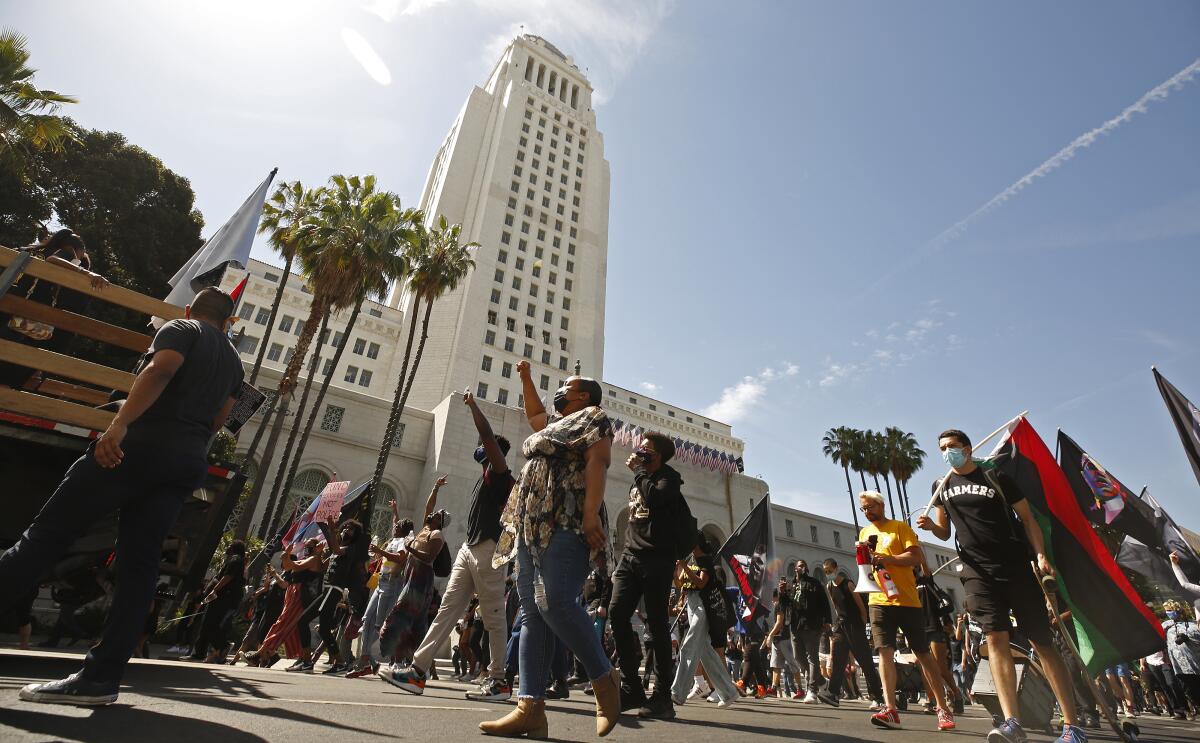Editorial: Yes, actually, Los Angeles needs more politicians

It’s time to enlarge the Los Angeles City Council, and maybe even double the number of elected council members. A 15-member City Council is simply too small to adequately represent a sprawling, diverse city of 4 million residents.
L.A. hasn’t increased the number of council districts since 1924. At that time, there were about 38,000 residents per district. Now, at roughly 260,000 residents per council member, L.A. has the largest council districts in the country.
Compare that to New York City, which has 51 City Council districts of 173,000 residents each, and Chicago, which has 50 districts of 55,000 residents each. L.A. districts are larger than many midsize cities across the country. Imagine having one elected representative for the entire city of Buffalo, N.Y., or Boise, Idaho.
How can residents of Winnetka or Westchester talk directly to their elected leaders about the need for a stop sign or a problem with illegal dumping when they have to compete for attention with a quarter of a million constituents? They often can’t. The reality of L.A. government is that little gets done for a community without its council member’s blessing. And when one council member represents 260,000 constituents, who is most likely to get their needs met first? Those with power, money and influence.
As part of the once-a-decade redistricting, a citizen commission this year held dozens of meetings to gather input from Angelenos on how to divvy up neighborhoods and community assets as they redrew the council district maps. Residents repeatedly complained that they were often ignored or forgotten by their council member.
Residents in Watts pleaded to be removed from Council District 15, where they feel like an unheard minority in the shadow of San Pedro. Thai Town residents worried their voices would be drowned out if they shared a district with more affluent Los Feliz. Neither community got what it wanted in the commission’s adopted map, released last month.
While the commission had its own problems (including political meddling and, now, the likelihood that the City Council is going to redo the commission’s work), the fact is that the job of redistricting L.A. is nearly impossible. There’s no good way to fairly divide a city this large into 15 council districts while trying to honor the wishes of various ethnic, religious and socioeconomic groups.
That’s why, in its final report, the commission included an analysis from Vice Chair Sonja F.M. Diaz that recommended increasing the number of council districts to at least 22 to better represent communities like Watts and Thai Town and give them more say in the selection of their council members.
But why stop at 22? With 31 council members each district would represent just 130,000 residents. (Also an odd number avoids tied votes.) And by cutting council members’ annual salary in half — from about $224,000 to $112,000 — the city could manage the expansion without breaking the bank. City Atty. Mike Feuer, who is running for mayor, said he plans to gather signatures to put an expanded City Council and an independent redistricting commission on the November 2022 ballot.
It’s true that past efforts to enlarge the City Council have failed. In 1999, voters approved a new City Charter to reshape L.A. government, but they overwhelmingly rejected separate ballot measures to increase the council to 21 or 25 members. The council expansion proposals became extraordinarily controversial, said Raphael Sonenshein, who was director of the appointed charter reform commission. Business groups pushed for a 35-member council more akin to an assembly, which could empower the mayor and block neighborhood councils, while some Black and Latino leaders warned the expansion could dilute their communities’ political power on the council.
Admittedly, this might not be the most opportune moment to urge Angelenos to go big on their local government, considering that three council members have been charged with corruption in the last two years.
Would a larger City Council and smaller council districts reduce corruption? It’s hard to say. Chicago has the smallest council districts of the big U.S. cities, with 50 aldermen representing about 55,000 residents each, but it’s had more than its share of indicted politicians. Still, L.A. as it is today invites corruption with its small and clubby City Council and the extraordinary power each member wields over development in their sprawling districts. Doubling the size of the council and reducing members’ discretion on land-use decisions would go a long way toward cleaning up City Hall.
Opponents, particularly incumbent council members, can always make the cynical argument against expansion — who wants more politicians? But more politicians also means more representation and more access to City Hall and city services.
Angelenos in recent years have backed major changes to L.A. government, including moving city elections to coincide with presidential and gubernatorial elections to boost voter turnout and approving the $1.2-billion Measure HHH to build homeless housing. There’s been a hunger to disrupt the status quo. And a bigger City Council would be a huge disruption — for the better.
More to Read
Updates
2:42 p.m. Feb. 25, 2022: This editorial was updated to include the author of the commission recommendation to expand the City Council.
A cure for the common opinion
Get thought-provoking perspectives with our weekly newsletter.
You may occasionally receive promotional content from the Los Angeles Times.










